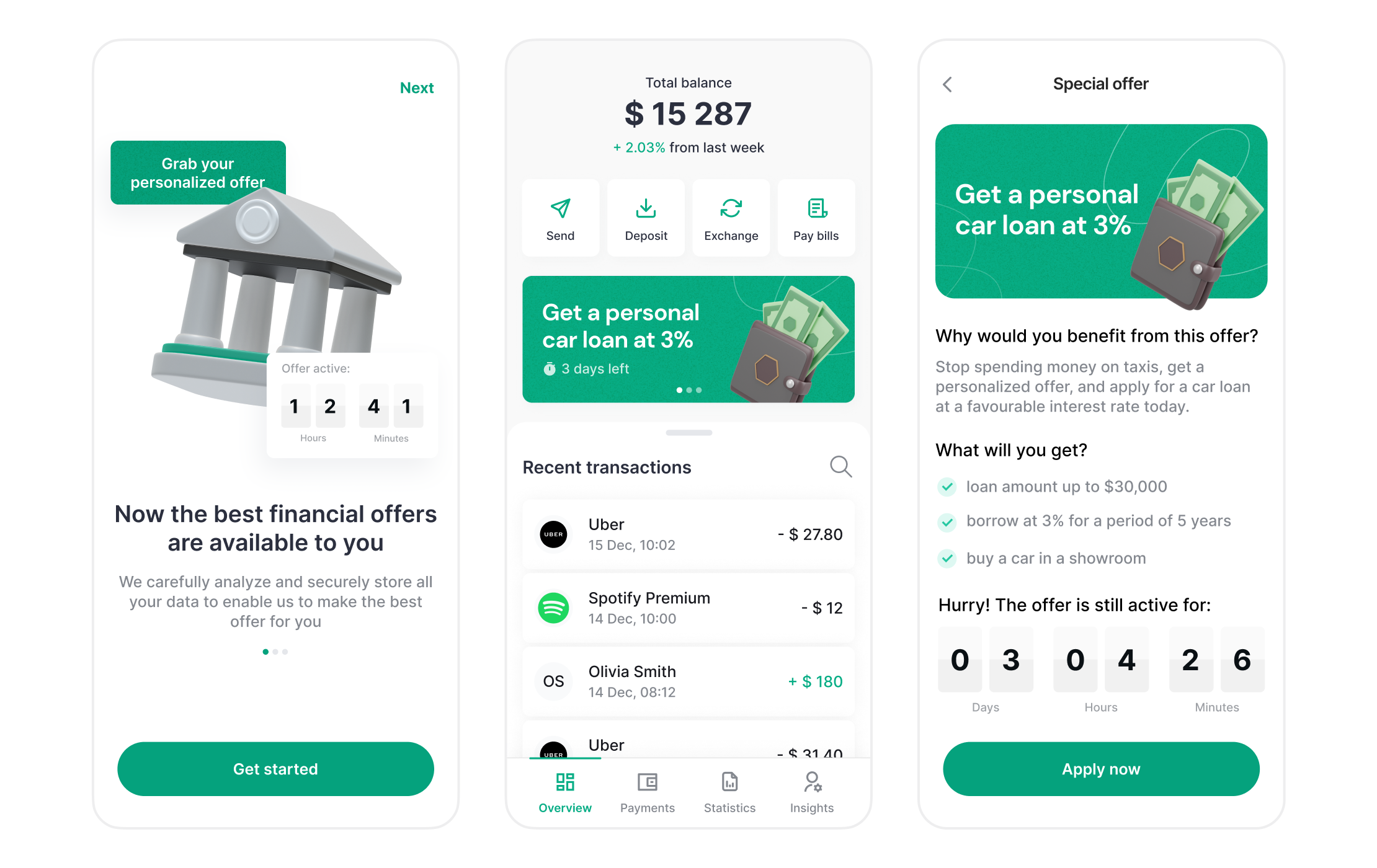Der Kunde hat beschlossen, seine vertraulichen Daten zu schützen
360-Grad-Ansichtslösung für das Privatkundengeschäft

Kundeninformationen
Eine Privatkundenbank, die über 10 Millionen Kunden betreut, hat sich an Andersen gewendet. Alle ihre Kunden interagieren regelmäßig mit der Bank und nutzen ihre Dienstleistungen. Um die Geschäftseffizienz zu erhöhen und die Kundendatenbank optimal zu nutzen, hat sich der Kunde entschieden, ein Tool etwickeln zu lassen, mit dem sich Kunden mit einer hohen Neigung zur Annahme von Cross-Sale-Angeboten identifizieren lassen. Außerdem haben sie die Gelegenheit, für jeden Kunden den bestmöglichen Ansatz zu ermitteln, gefordert. Zusammenfassend war eine 360-Grad-Ansichtslösung erforderlich.
![[object Object] on the map](https://static.andersenlab.com/andersenlab/new-andersensite/bg-for-blocks/about-the-client/germany-desktop-2x.png)
Projektübersicht
Andersens Kunde betreibt jetzt eine einheitliche Datenbank mit 360-Grad-Kundenansichten. Jedes der gespeicherten Profile enthält einen Verlauf der Interaktionen und der Angebote, darunter berechnete Kapitalwerte für jedes Produkt und jeden Kanal. Die Angebote werden auf Black-Box-Basis mit Test- und Kontrollgruppen zugewiesen. Während der Teilnahme an dieser Initiative war sich Andersens Team nicht der genauen Logik bewusst, die bei der Zuweisung von Test- und Kontrollgruppen oder Angeboten angewendet wurde. Diese Situation ist durchaus typisch, da die Angebote durch verschiedene Abteilungen, Teams oder Systeme bearbeitet werden können, sowohl manuell als auch auf Basis von A/B-Tests.

Bei der Zusammenarbeit haben wir uns auf das Folgende konzentriert:
- Lösung der Probleme mit dem Legacy Data Warehouse (DWH) des Kunden. Das Problem bestand darin, dass es über komplexe ETL-Pipelines verfügte und sehr teuer wegen der Basis von Oracle Exadata war. Der Kunde wollte die Kosten reduzieren und Business Intelligence hinzufügen;
- Feinabstimmung des Datensynchronisierungsprozesses zwischen Client-Apps, Kanälen, dem Data Warehouse und den Aufzeichnungssystemen;
- Arbeit am Datensee des Kunden.

Anforderungsanalyse und Marktforschung
Zuerst überprüften und analysierten unsere Spezialisten sorgfältig den aktuellen Stand des Kunden und seine technischen Fähigkeiten entsprechend seinen Anforderungen. Das Team von Andersen hat auch eine umfangreiche Marktforschung durchgeführt. Danach formulierten wir die Hauptidee zur Systemverbesserung des Kunden, sozusagen haben wir uns entschieden, es in ein Data Lakehouse basierend auf Open-Source-Technologien zu migrieren.

Projektfortschritt
Herausforderungen
Die für Test- und Kontrollaufgaben verwendete Logik war uns unbekannt. Genauer gesagt gab es keine Garantie dafür, dass diese nicht zufällig vorgeschlagen wurden. Daher musste jede Leistungsbewertung des Kundenmodells ausschließlich auf Datenverlauf basieren. Diese Daten könnten willkürliche Vorurteile widerspiegeln.
Im Idealfall würden wir jede Modellversion durch randomisierte Experimente bewerten. Aus Sicht des Kundenerlebnisses sind solche Tests jedoch im Allgemeinen teuer und riskant. Daher mussten wir eine Offline-Bewertungsmethodik entwickeln, die die Anzahl der Online-Tests reduziert und das Risiko katastrophaler Richtlinien verringert.
Lösung
Andersens Team entwickelte ein Verfahren zur Bias-Kontrolle und -Korrektur, um mögliche Bias im Datenverlauf zu beseitigen. Unser Team hat ein Kernmodell konzipiert, das sich auf die Produkt- und Kanalbalance konzentriert. Das Ziel bestand darin, die Verkaufswahrscheinlichkeit einzuschätzen, die sich aus verschiedenen Arten von Angeboten ergeben. Dies trug außerdem dazu bei, die optimale Next-Best-Offer-Strategie für jeden Kunden, jedes Produkt und jeden Kanal zu ermitteln.
Auf der Grundlage von Wahrscheinlichkeitswerten (dem präskriptiven Teil des Modells von Next-Best-Offer-Strategie), implementierten wir die Logik zur Auswahl des Angebotstyps. Die Spezialisten von Andersen haben ein Bewertungsverfahren entwickelt, um die Qualität des Modells anhand der voreingenommenen Daten zu beurteilen.

Projektergebnisse
Als Ergebnis unserer Arbeit konnte der Kunde mithilfe einer Quelle genauer Informationen einen endgültigen Beleihungswert berechnen und verbessern. Alle Daten sind in einem zentralen Repository leichtzugänglich, was den Integrationsdauern und -kosten reduziert.
- Um 40 % gestiegene Konversionsrate durch personalisierte Angebote;
- 87 % Kundenzufriedenheitswert (CSAT) für ausgewählte Produkte;
- Um 23 % gestiegene Leserate und Klickrate.
Aspekte der Business-Analyse
Der Beitrag unserer Businessanalysten bestand aus:
- Suche nach den wesentlichen Attributen, die zur Identifizierung von Kundenzielgruppen erforderlich sind;
- Synchronisierung des Datenflusses für den Aufbau einer reibungslosen Datenflussberechnung;
- Testen von Hypothesen mit Datenverlauf;
- Entwicklung eines Modells der mehrstufigen Datenverarbeitung mit einer minimalen Systembelastung.
Sequenzdiagramm

Projektergebnisse
- Dokumentation und Entwicklung von „as is“ und „to be“ Modellen des Datenaustauschs;
- Ausarbeitung eines flexiblen Systems von Indikatoren und Berichten zur Analyse der Lösungsergebnisse;
- Integration der Kalibrierungssystemfunktion in eine Software.
Kostenlose Beratung anfordern
Weitere Schritte
Nachdem wir Ihre Anforderungen analysiert haben, meldet ein Experte bei Ihnen;
Bei Bedarf unterzeichnen wir ein NDA, um den höchsten Datenschutz sicherzustellen;
Wir legen ein umfassendes Projektangebot mit Kostenschätzungen, Fristen, CVs usw. vor.
Kunden, die uns vertrauen:

